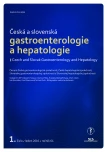Neuroendocrine Tumors of the Large Bowel
Authors:
O. Louthan
Authors‘ workplace:
Ambulance pro neuroendokrinní nádory, IV. interní klinika 1. LF UK v Praze, VFN, Praha
Published in:
Gastroent Hepatol 2010; 64(1): 22-26
Category:
Review Article
Overview
Neuroendocrine tumors (NET) of the proximal part of the large intestine, i.e. cecum, ascending colon and proximal part of transversal colon, are mostly biologically inactive, so they do not cause carcinoid syndrome. Their malignant potential is slightly higher compared to rectal NETs, and metastases occur in one-third of cases at the time of diagnosis. The factors determining metastatic behavior include: tumor size greater than 2 cm, higher tumor grading, invasion into muscularis propria, angioinvasion and perineural invasion, metastases into lymphatic vessels and lymph nodes and higher proliferation index Ki-67. Diagnostic tactics are based on usual localization techniques, tumor staging includes performing an octreoscan as well. Prostatic acid phosphatase and serum chromogranin A are used as oncomarkers. Surgical removal is the only radical treatment. As concerns palliative therapy, there is no consensus in terms of somatostatin analogs treatment because of the absence of carcinoid syndrome in NETs in this location. Some new clinical studies confirm a tumoristatic effect even in biologically inactive NETs. Response rate is low in interferon alpha for monotherapy and for chemotherapy. Invasive forms of cytoreduction and prospectively new modalities such as targeted radiotherapy come into question. 5-year survival rate is 40–70 %.
Key words:
neuroendocrine tumors of the large intestine – chromogranin A – somatostatin analogs – carcinoids
Sources
1. Williams ED, Sandler M. The classification of carcinoid tumours. Lancet 1963; 1(7275): 238–239.
2. Solcia E, Klöppel G, Sobin LH. Histological Typing of Endocrine Tumours. Second Edition, World Health Organisation, International Histological Classification of Tumours. 2000; Springer: Berlin-New York.
3. Capella C, Heitz PU, Hofler H. Revised classification of neuroendocrine tumours of the lung, pancreas and gut. Virchows Archiv 1995; 425(6): 547–560.
4. Modlin IM, Lye KD, Kidd M. A five-decade analysis of 13,715 carcinoid tumors. Cancer 2003; 97: 934–959.
5. Greenstein AJ, Balasubramanian S, Harpaz N. Carcinoid tumor and inflammatory bowel disease: a study of eleven cases and review of the literature. American Journal of Gastroenterology 1997; 92(4): 682–685.
6. Klöppel G, Rindi G, Anlauf M. Site-specific biology and pathology of gastroenteropancreatic neuroendocrine tumors. Virchows Archiv 2007; 451(Suppl 1): S9–S27.
7. Rindi G, Villanacci V, Ubiali A. Biological and Molecular Aspects of Gastroenteropancreatic Neuroendocrine Tumors. Digestion 2000; 62(Suppl 1): 19–26.
8. Barakat MT, Meeran K, Bloom SR. Neuroendocrine tumours. Endocrine Related Cancer 2004; 11(1): 1–18.
9. Kaltsas GA, Besser GM, Grossman AB. The diagnosis and medical management of advanced neuroendocrine tumours. Endocrine Reviews 2004; 25(3): 458–511.
10. Kimura N, Sasano N. Prostate-specific acid phosphatase in carcinoid tumors. Virchows Archiv – A Pathological Anatomy and Histopathology 1986; 410(3): 247–251.
11. Ardill JE, Erikkson B. The importance of the measurement of circulating markers in patients with neuroendocrine tumours of the pancreas and gut. Endocrine Related Cancer 2003; 10(4): 459–462.
12. Ramage JK, Goretzki PE, Manfredi R et al. Consensus Guidelines for the Management of Patients with Digestive Neuroendocrine Tumours: Well-Differentiated Colon and Rectum Tumour/Carcinoma. Neuroendocrinology 2008; 87(1): 31–39.
13. Ricke J, Klose KJ. Imaging Procedures in Neuroendocrine Tumours. Digestion 2000; 62(Suppl.1): 39–44.
14. Kwekkeboom D, Krenning EP, de Jong M. Peptide receptor imaging and therapy. Journal of Nuclear Medicine 2000; 41(10): 1704–1713.
15. Spread C, Berkel H, Jewell L et al. Colon carcinoid tumors. A population based study. Diseases of Colon and Rectum 1994; 37(5): 482–491.
16. Federspiel BH, Burke AP, Sobin LH et al. A clinicopathologic study of 84 cases. Cancer 1990; 65(1):135–140.
17. Öberg K. Carcinoid Tumors: Current Concepts in Diagnosis and Treatment. The Oncologist 1998; 3(5): 339–345.
18. Arnold R, Rinke A, Müller HH et al. Placebo-controlled, double blind, prospective, randomized study on the effect of octreotide LAR in the control of tumor growth in patients with metastatic neuroendocrine midgut tumors: a report from the PROMID study group.
Presented at: ASCO-GI Cancers Symposium, January 2009, San Francisco, USA.
19. Öberg K.: Established Clinical Use of Octreotide and Lanreotide in Oncology. Chemotherapy 2001; 47(suppl 2): 40–53.
20. Öberg,K. Neuroendocrine gastrointestinal tumours. Ann Oncol 1996; 7(5): 453–463.
21. Rougier PH, Mitry E. Chemotherapy in the treatment of neuroendocrine malignant tumors. Digestion 2000; 62(suppl 1): 73–78.
22. Otte A, Mueller-Brand J, Dellas S et al. Yttrium-90-labelled somatostatin analogue for cancer treatment. Lancet 1998; 351(9100): 417–418.
23. Lewington WJ. Targeted radionuclide therapy for neuroendocrine tumour. Endocrine-Related Cancer 2003; 10: 497–501
24. Roche A, Girish GV, DeBaere T et al. Trans-catheter arterial chemoembolization as first-line treatment for hepatic metastases from endocrine tumours. European Radiology 2003, 13(1): 136–140.
Labels
Paediatric gastroenterology Gastroenterology and hepatology SurgeryArticle was published in
Gastroenterology and Hepatology

2010 Issue 1
- Metamizole at a Glance and in Practice – Effective Non-Opioid Analgesic for All Ages
- Metamizole vs. Tramadol in Postoperative Analgesia
- Current Insights into the Antispasmodic and Analgesic Effects of Metamizole on the Gastrointestinal Tract
- Metamizole in perioperative treatment in children under 14 years – results of a questionnaire survey from practice
- Possibilities of Using Metamizole in the Treatment of Acute Primary Headaches
Most read in this issue
- The Diagnosis and Treatment of Globus Pharyngeus
- Recommendation for Vaccinations in Patients with Crohn’s Disease and Ulcerative Colitis on Immunosuppressive and/or Biological Therapy
- Neuroendocrine Tumors of the Large Bowel
- Enteropathy-Associated Non-Hodgkin T-Lymphoma as a Complication of Late Diagnosis of Celiac Disease in a Geriatric Patient
